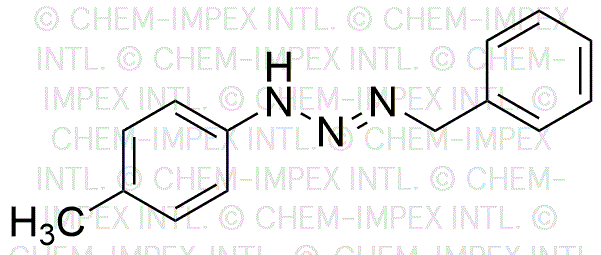1-Benzyl-3-p-tolyltriazene is widely utilized in research focused on:
- Organic Synthesis: This compound serves as an important intermediate in the synthesis of various organic compounds, particularly in the development of azo dyes, which are used extensively in textiles and food coloring.
- Pharmaceutical Research: It is explored for its potential applications in drug development, particularly in creating compounds that exhibit anti-cancer properties, providing researchers with new avenues for treatment options.
- Material Science: The compound is used in the formulation of advanced materials, including polymers and coatings, enhancing properties such as durability and resistance to environmental factors.
- Analytical Chemistry: It acts as a reagent in various analytical techniques, helping in the detection and quantification of other chemical substances, which is crucial for quality control in manufacturing.
- Colorimetric Applications: Due to its vibrant color properties, it is used in colorimetric assays, allowing for easy visual detection of chemical reactions, which is beneficial in both educational and industrial settings.
General Information
Properties
Safety and Regulations
Applications
1-Benzyl-3-p-tolyltriazene is widely utilized in research focused on:
- Organic Synthesis: This compound serves as an important intermediate in the synthesis of various organic compounds, particularly in the development of azo dyes, which are used extensively in textiles and food coloring.
- Pharmaceutical Research: It is explored for its potential applications in drug development, particularly in creating compounds that exhibit anti-cancer properties, providing researchers with new avenues for treatment options.
- Material Science: The compound is used in the formulation of advanced materials, including polymers and coatings, enhancing properties such as durability and resistance to environmental factors.
- Analytical Chemistry: It acts as a reagent in various analytical techniques, helping in the detection and quantification of other chemical substances, which is crucial for quality control in manufacturing.
- Colorimetric Applications: Due to its vibrant color properties, it is used in colorimetric assays, allowing for easy visual detection of chemical reactions, which is beneficial in both educational and industrial settings.
Documents
Safety Data Sheets (SDS)
The SDS provides comprehensive safety information on handling, storage, and disposal of the product.
Product Specification (PS)
The PS provides a comprehensive breakdown of the product’s properties, including chemical composition, physical state, purity, and storage requirements. It also details acceptable quality ranges and the product's intended applications.
Certificates of Analysis (COA)
Search for Certificates of Analysis (COA) by entering the products Lot Number. Lot and Batch Numbers can be found on a product’s label following the words ‘Lot’ or ‘Batch’.
*Catalog Number
*Lot Number
Certificates Of Origin (COO)
This COO confirms the country where the product was manufactured, and also details the materials and components used in it and whether it is derived from natural, synthetic, or other specific sources. This certificate may be required for customs, trade, and regulatory compliance.
*Catalog Number
*Lot Number
Safety Data Sheets (SDS)
The SDS provides comprehensive safety information on handling, storage, and disposal of the product.
DownloadProduct Specification (PS)
The PS provides a comprehensive breakdown of the product’s properties, including chemical composition, physical state, purity, and storage requirements. It also details acceptable quality ranges and the product's intended applications.
DownloadCertificates of Analysis (COA)
Search for Certificates of Analysis (COA) by entering the products Lot Number. Lot and Batch Numbers can be found on a product’s label following the words ‘Lot’ or ‘Batch’.
*Catalog Number
*Lot Number
Certificates Of Origin (COO)
This COO confirms the country where the product was manufactured, and also details the materials and components used in it and whether it is derived from natural, synthetic, or other specific sources. This certificate may be required for customs, trade, and regulatory compliance.

